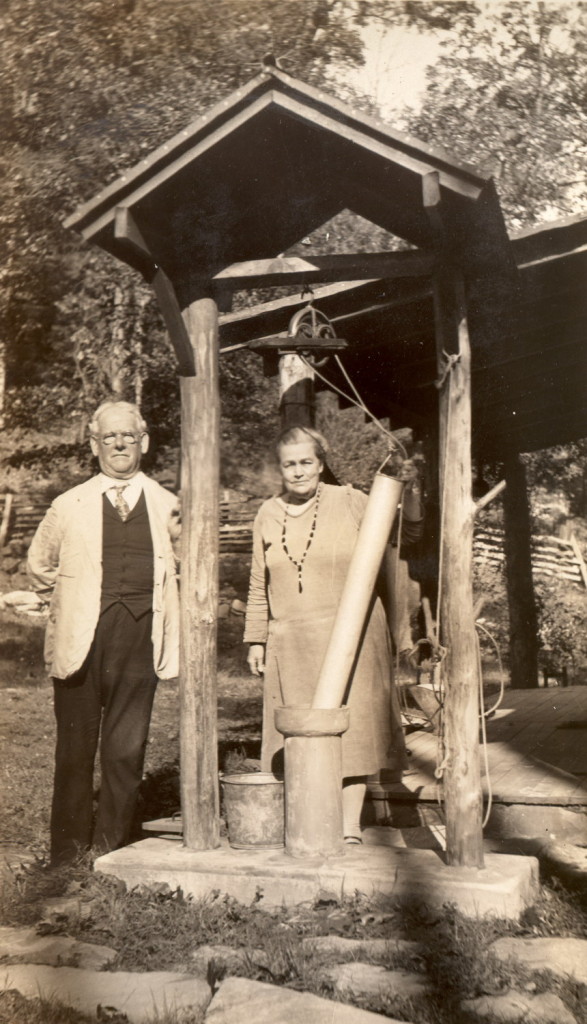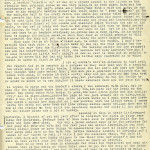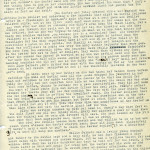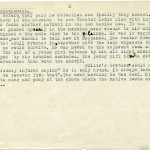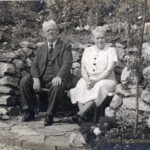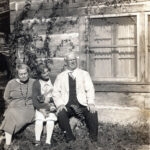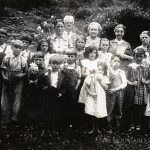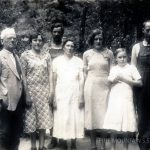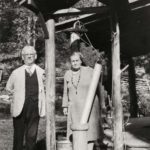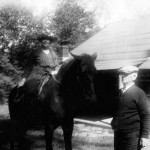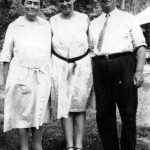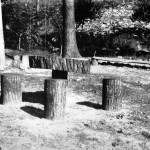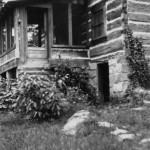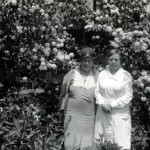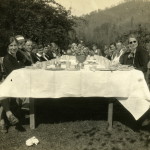Pine Mountain Settlement School
Series 09: BIOGRAPHY – Staff
Series 14: MEDICAL
Dr. Ida Stapleton (1871-1946)
Rev. Robert Stapleton (1866-1945)
Line Fork Staff 1926-1937
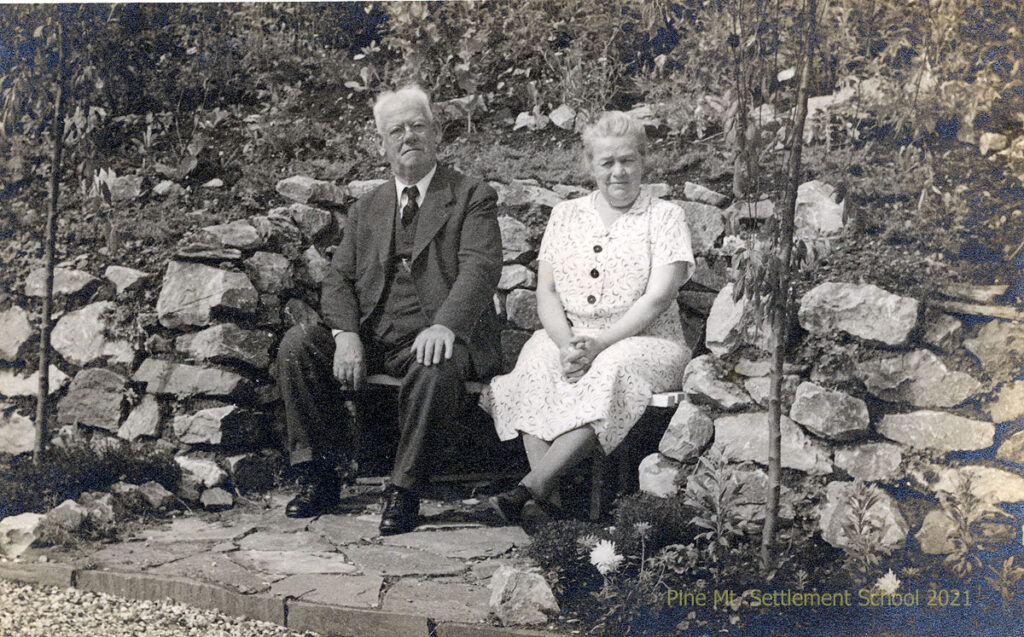
444 Rev. and Dr. Ida Stapleton at Line Fork Settlement. [creech_columbus_4_444.jpg]
TAGS: Ida Stapleton, Robert Stapleton, Line Fork Medical Settlement minister and doctor, medical settlements, Marguerite Butler, Katherine Pettit, Gretchen Rasch, great-granddaughter, Christian Armenians during WWI, Ottoman Turks, American Board of Commissioners for Foreign Missions (ABCFM), Erzerum, Turkey (now Russia), Alice G. Bingham
Dr. IDA STAPLETON and Rev. ROBERT STAPLETON Staff
Dr. Ida Stapleton, Medical Doctor & Co-Administrator, Line Fork 1926-1937
Rev. Robert Stapleton, Minister & Co-Administrator, Line Fork 1926-1937
The Stapletons arrived at Line Fork on August 30, 1926. They came to the remote settlement to replace Miss Alice G. Bingham who had departed the position of settlement director after only five months at the job. Dr. Ida Stapleton and the Rev. Robert Stapleton were at the end of long careers that had focused on populations suffering from war, disease, deprivation, illiteracy, and a myriad of other hardships. They were well-equipped to address life on Line Fork and they stayed for nearly eleven years.
A biography of the Stapletons has been provided by Gretchen Rasch, great-granddaughter of the Stapletons who lives in New Zealand. The family biography fills in many of the gaps in the lives of these two remarkable people.
BIOGRAPHY
By Gretchen Rasch, Great-granddaughter of the Stapletons
21 February 2014
[Used with the author’s permission.]
Robert Stapleton was born in Belfast, Ireland, in 1866 to English parents, who were in Ireland temporarily from their home in Manchester. Robert’s mother worked in the Manchester cotton mills before her marriage, and his father (also Robert) was a printer for the Manchester Guardian newspaper. He became a minister when son Robert was ten years old. Robert left school at fourteen to become an apprentice in a lace factory in the Derbyshire town of Long Eaton where Robert senior was the local Congregational minister. In 1883 the family of six emigrated to Michigan where Robert’s father was minister to Congregational churches in Michigan, Iowa, and Ohio. After a series of jobs including teaching and working for a wholesale grocery, young Robert was able to attend college at Olivet, Michigan, where he met his future wife Ida Salmond at a club for aspiring missionaries. Olivet, a small liberal arts college associated with the United Church of Christ and the National Association of Congregational Christian Churches provided preparation that was similar to the mission of Pine Mountain — ”…intellectual, moral and spiritual improvement, and…the Divine art and science of doing good to others. From its beginning, the college’s founders and leaders believed an education should be available to anyone regardless of gender, race or ability to pay.” While the Stapletons were attending the school it garnered a national reputation for its instructional methods based on the “‘Oxford model,’ a tutorial system used in European universities that relied heavily on seminars and interaction between faculty and students.”
Ida’s parents were farmers in Lapeer, Michigan, and Ida was born in 1871, the third of seven children. She began teaching locally at the age of sixteen, and later graduated from Lapeer High School. She was able to afford only a year at Olivet College. It was long enough for her to fall in love with Robert and for the two of them to dedicate themselves to the missionary cause. While Robert finished his undergraduate work at Olivet, Ida spent two years in Alabama and Georgia under the auspices of the American Missionary Association teaching in schools for the children of freed slaves. While she was there she became convinced that the poor needed health care as much as religion and education to improve their lives. She intended to complete a nursing qualification while Robert attended the Chicago Theological School. However the opportunity came to study for a medical degree at the Woman’s Medical College of the New York Infirmary for Women and Children. Ida entered the college in 1894, graduating with sixteen other women in 1898.
Robert completed his Divinity degree a year before Ida was due to finish her medical course. They were married in New York in October 1897 and Robert left ten days later for Turkey (then the Ottoman Empire). Ida joined him a year later and they spent the next eighteen years in the city of Erzurum in eastern Turkey (now under Russian control), ministering to the Christian Armenian population. The Stapletons were part of the American Board of Commissioners for Foreign Missions (ABCFM), a Boston-based organisation which at that time had over five hundred missionaries on five continents. Erzerum was a hard posting; it was a garrison town not far from the Russian border and a centre of trade for the caravan routes from Russia and Persia. Spiritual matters came a poor third to military and commercial interests. The city was high on a harsh and barren plateau with short, hot summers and bleak winters. Nonetheless the Stapletons came to love their challenging environment, but it came at a cost. Like most missionaries in Turkey, the Stapletons were required to bury two of their children after they succumbed to the many diseases which ravaged the Empire’s populations. While Robert busied himself with the missionary schools and village churches, Ida raised their three daughters and had a small practice as a doctor. The government in Constantinople (Istanbul) refused to allow her to take the exams so she might be licensed as a doctor (only two or three women were ever allowed to practice legally). Nonetheless the capital was a long way from Erzerum and the local authorities were happy that Ida looked after the Armenian poor, the foreign diplomatic circle, and a large number of Turkish women (including the governor’s wife).
When the First World War broke out in 1914, Robert and Ida found themselves witnesses to the first great tragedy of the twentieth century: the attempt by the Ottoman government to exterminate the Armenian population. Nearly all Armenians were massacred or deported from their homes throughout Turkey, and a great portion of those not killed outright died of disease or starved to death. The missionaries saved those they could; Robert and Ida were sheltering over twenty women and children when the Russian army advanced on Erzerum. The Ottoman governor offered them transport to leave the city along with the government and the Turkish army but they refused, knowing what would happen to their wards if they abandoned them. As the city was shelled by Russian artillery and mobs roamed the streets, the Stapletons thought their time had come but fortunately the Russian troops entered the city and order was restored. The Stapletons and their Armenian dependents were then able to travel through the Caucasus Mountains, to St. Petersburg and then Sweden and Norway before boarding a ship for New York.
Robert soon returned to Erzurum (now under Russian rule) while Ida established their daughters at the boarding home in Oberlin, Ohio, for the children of missionaries. After the Russian October Revolution in 1917 and the armistice between Russia and Germany, Russian troops withdrew from eastern Turkey. Robert and other missionaries were forced to flee on a harrowing journey through south Caucasian battlefields to the Caspian Sea, up the Volga River and across Siberia to the Pacific Coast.
As the war wound down, Robert and Ida returned to Turkey to help with the massive American relief effort that continued through the 1920s. They were based in Trebizond (Trabzon) on the Black Sea until the ABCFM made the decision to close the station in 1923. They went back to Oberlin, Ohio, where their three daughters had attended Oberlin High School and Oberlin College. The college had close links to the foreign missionary community and to Pine Mountain as well; and as Robert and Ida cast around for a new work in their lives they were offered the opportunity to go to Line Fork Settlement in Kentucky.
Their impressions of Line Fork are mostly from the reports and letters Ida wrote. Clearly she relished being back in a verdant rural setting after the arid bleakness of central Turkey. Although the two worlds appeared so different she found a number of similarities. For example the problem of trachoma among the people of the Line Fork area was similar among the Armenian poor of Turkey. Many other struggles of the poor in Kentucky were little different from the struggles of the poor in Turkey, or anywhere else for that matter. Ida was deeply interested in the lives of the people around them and wrote of their hard lives, their family dramas and their efforts to improve their situations.
Ida served the people of Line Fork to the best of her abilities and her deep Christian sense of love and duty. At all hours and in all sorts of weather Robert would saddle and load Mare Swallow and Ida would ride out over the rough roads and teeming creeks to attend her patients.
When the Cabin burned down in 1929, Robert and Ida would have found it all too familiar. In Turkey they had lost their girls’ school to fire in 1904. Later that year, the boys’ school also burned down. When the girls’ school was burning Ida had to leave her home for safety’s sake, carrying her new-born daughter through the frozen streets at night to another house. Robert would have thoroughly enjoyed the process of rebuilding the Cabin, having overseen the rebuilding of two schools in Turkey under extremely trying conditions.
The Stapletons spent eleven years (1926-1937) at Line Fork. They left Kentucky to visit their eldest daughter in Germany in 1938, and then retired to Lapeer, Michigan, where they lived with Ida’s sister Carrie. Ida stayed in touch with a number of her friends at Line Fork for the rest of her life and often sent clothes and presents to them. Robert passed away in 1945 and Ida followed him in 1946.
STAPLETON REPORTS to Director and Trustees
Pine Mountain Settlement School served as the administrative center for both the Line Fork Settlement and the Medical Settlement at Big Laurel. Dr. Ida Stapleton was both the physician assigned to Line Fork, as well as its administrator. She was required to complete a series of reports for Katherine Pettit and for the board of trustees of Pine Mountain School on the work at Line Fork. These reports are filled with information of the couple’s endeavors to address the many issues they encountered with their work, but they also contain anecdotal personal reflections on their interactions with the diverse community of Line Fork.
The first report of the Stapletons details their arrival at “The Cabin” at Line Fork in August of 1926 and the first four months’ adventures at the remote settlement. Following this initial report, there were many others over the course of eleven years, mainly written by Dr. Ida Stapleton. For links to the reports go to:
Dr. IDA STAPLETON & Rev. ROBERT STAPLETON Guide to Reports 1926 – 1936
The GUIDE lists the individual quarterly and monthly reports and Letters to friends of Dr. Stapleton. The pages are linked as separate pages and are titled by date and the first line of the report. The reports are similar in detail to the following transcription by Rev. Stapleton. Not all reports are accounted for in the years that the Stapletons were in residence at Line Fork and there may be a few missing reports, or those few that may not have followed a monthly schedule, or may be lost. However, the reports of the Stapletons are some of the richest records available on life in the far-flung communities and homes surrounding Pine Mountain.
“Some Experiences in the life of the Doctor …”
[Reflections on Experiences at Line Fork by Rev. Robert Stapleton]
This summary assessment was written by Rev. Robert Stapleton and was derived from the letters of Dr. Stapleton and friends. It includes his reflections on the work at Line Fork and quickly establishes the context for the couple’s work at Line Fork. It is used here as an introductory piece. Rev. Stapleton’s commentary is not dated but it helps to set the background for their work with the Line Fork community and underscores the many challenges the couple faced in the years they lived in “The Cabin.”
- Dr. Ida Stapleton, “Some Experiences in the Life of the Doctor” as Mrs. Stapleton has described them in letters to friends. [Rev. Stapleton transcription] [lf_stapletons_001.jpg]
- Dr. Ida Stapleton – Some Experiences in the life of the Doctor as Mrs. Stapleton has described them in letters to friends. [Rev. Stapleton transcription] lf_stapletons_002.jpg
- Dr. Ida Stapleton – Some Experiences in the life of the Doctor as Mrs. Stapleton has described them in letters to friends. [Rev. Stapleton transcription] lf_stapletons_003.jpg
Some Experiences in the life of the Doctor as Mrs. Stapleton has described them to friends.
In some ways it is a little better than I feared but on the whole it will claim our very best endeavors to make any impression on entrenched customs and the indifference, that lack of stimulus has inbred in the people. Yesterday I went to visit an old man who was shot in the arm about two weeks ago. A regular “shooting up” it was by a nephew crazed by the liquor he had steadily been imbibing since he was very young. He is even known thru out the neighbourhood as “Bad Boy” – still only twenty-one with a wife and baby. He had gone to his cousin’s wedding dinner and there began to “cuss his woman” as the one said who told us the story first. His uncle and cousin tried to pacify him and prevent him from shooting her as he threatened. Then his anger turned on them and he shot into the midst of the group, killing one young man instantly, destroying the middle finger of the second and shooting twice through the arm of his uncle. He was not so crazy but that he ran away and left them to their sorrow and did not dare to go back and everybody is giving him a wide berth. He is under bond to appear for making hooch, so when that case is settled perhaps he will be arrested for this and put where such a thing can never happen again.
They came for me at three o’clock A.M. to dress the wounds. I can’t describe that dark ride – a tiny light held by the boy who rode behind the one leading the way – then the disordered room, the wailing mother for her youngest son and his heart-broken little wife, who between her sobs lamented “How can I go home without my little boys’ pappy? He was so good to them and so helpful to me, and he never did Bad Boy any harm. The little boys quarreled as to which should be taken up first &c &c.”
I did my nurse’s best in cleaning up that mess. The fingers had to be removed by a surgeon so they took that man to a hospital ten miles away. He is still there. I dressed the old man’s arm once and then they thought they knew better than I did and put a poultice of slippery elm bark mixed with milk. Of course it could hardly help but get infected and they took him to another doctor ten miles away, but yesterday he was too feeble to go again and asked me to see him. Now it needs constant care and the poor old wife is trying to carry out the doctor’s orders. I was consumed with pity, not so much for the oldlings whose race is nearly run, but more for the group on the porch – two young women with babies in arms, two half grown girls and six smaller fry – all so piggy, piggy, indeed the pigs in the yard seemed not so dirty, being pigs. I had put in my pocket some Bible picture cards as I went there not knowing where I should sow them. But as I was passing thru the little group I remembered the cards and gave them out into grubby little hands telling them one or two of the stories so they could see something besides the color in the picture but the colors alone are a bit of beauty.
Looking at them in their little ragged garments, I thought of you and your offer to interest the girls in doing something for Christmas. Perhaps some of them would like to prepare dolls for the three and four year olds. One day a young mother came to me for medicine for her year old baby and with her the four year old sister Isabelle. In our nice little clinic house we have things to demonstrate the care of babies and a rather large doll sits in the bath tub. Little Isabelle touched it lovingly and I asked her if she wanted to hold it while I got the medicine ready. She held it with such care and then Mandy slipped to the floor from her mother’s lap and held up thin little arms for the doll, almost as heavy as herself.
Most of my work is done in exchange for fruit and vegetables and eggs although they do pay money at times which goes to pay for the keep of the horse “Mare Swallow”. Robert and I use her in turn, or when we go together he walks, or if the distance is too far we hire another horse for the day.
The Cabin is cozy in many respects but it is not quite all I would wish it were. It is so low and the windows are so shaded the sunshine can hardly penetrate the living room at all, a rather serious fault I think but of course it is much better than these cabins with no windows at all. The little lean-to kitchen is all right. The small wood and coal cook stove is a good one when the smoke goes up the chimney.
It was Christmas night at the Cabin in Line Fork Valley. There came a knock at the door about 11:30 and Su Ingram was admitted. Her sister Tilly had been returning from the Begleys and as the Fork had risen she was forced to wade it with the result that exposure had brought on such cramps she was “like to die and wouldn’t the doctor come and see her”. She herself had come away without taking time to put on her stockings. She had bridled the mule that “nary a woman could ever ride” and with her little carbide light had posted the two miles as fast as she could.
The doctor got fully dressed while her husband was getting Mare Swallow and selecting a few remedies that might be useful, followed after Su – flashlight in hand. Su’s mule started at a good pace and Swallow followed suit, but at the first soft spot went down on her knees and the doctor went over her head so suddenly she didn’t even drop the flashlight. For a moment she thought she could not go on as her lip was bleeding and one knee was bruised. But as she was trying to tell Su what to do she felt better and there was Swallow waiting, so leading her to a convenient rock she mounted and followed on a little more carefully. The carbide light is better than the flashlight but the wind repeatedly blew it out and Su as often relit it by scratching a match on her saddle. But finally it would not relight and the flash was sufficient to guide one over the many little torrents that were pouring down the mountainside. The branches were really formidable to the doctor but not to Jack or Swallow; they wade thru without any fuss. After the second was passed Su hurried on as she was getting cold and the doctor made the last half mile alone losing her hat as she passed under some low hanging branches she did not see in the dark. She “left it lay” until her return when Lige Cornett, Su’s father who came with the doctor as far as the second branch on her return, retrieved it and it was thankfully restored to the doctor’s head.
Su lives near by her father so she had taken her babies there before catching the mule and having done all she could wrapped the youngest in her coat and returned to her cabin leaving the doctor to do what she could for Tildy, for Tildy had not departed this life as was feared she would but was even then some better, thanks to nothing but a good constitution. They did not make the most of their grate fire, not having filled the coal pail. Tildy’s mother rebuked her twelve year old son for mending the fire with the poor sticks that she was aiming to use in getting the breakfast ready. The doctor insisted that the boy bring in more coal, seconded by Lige who was stretched out on the bed. Then Frank started to get the bucket but found it stuck tight in a lard pail and he could not get it out. This was done with the assistance of the doctor and then Lige arose and with the carbide light led the way.
Tildy was sitting hunched up with her head in mammy’s lap, bare feet on the cold floor and all too thinly clad. Every few minutes a gust of wind blew down the chimney and we were all covered with soot. The room looked as it had gone thru that experience many times it was so grimy.
The sick one finally became warm enough and was willing to go to bed and about three o’clock the doctor started home. Poor old Lige said plaintively “I haven’t nary a cent to pay” to which the doctor replied, “It is a Christmas gift, we must all help one another”.
Willie Cornett was a loving young husband and father to two little boys and a baby girl. He had just finished a nice board cabin with windows and sealed walls. But he had a terrible thirst for moonshine. Even when his little daughter lay dead he went off for the drink. A few weeks later he went off again for drink and the doctor met his wife as she was on her way to persuade him to return home on Sunday afternoon. For the time she succeeded, but early in the evening he was mastered again by the thirst for more and in spite of his wife’s pleadings he went off. About eight o’clock the Henry Lewises heard shoutings up on the high road but having heard them many times before, they paid no attention and finally they ceased. The doctor was going down in the morning to see Chester Lewis sick with inflammatory rheumatism and found another patient on the bed beside him. It was Willie Cornett who had been picked up early in the morning near enough to his mule’s heels to have been kicked – the mule tied to the palings. He was in terrible pain and tho conscious, was unable to tell how it happened. The doctor dressed the wound and found the skull crushed in; together with the long exposure there was little hope that he would survive. He was moved to the adjacent room and his young wife with the aid of a young girl watched by him all night, assisted or more truly, annoyed by his drunken comrades. The young girl tried to get them to go away and threatened them with the sheriff.
Willie’s brother could not think he was so seriously injured saying, “He is only drunk. It always takes him three days to recover from that”. The next morning he was dead. Mr. Stapleton was asked to sing and pray at the grave where the native rocks are the only headstones.
GALLERY: Dr IDA STAPLETON and Rev ROBERT STAPLETON Staff
- 444 Rev. and Dr. Ida Stapleton at Line Fork Settlement. [creech_columbus_4_444]
- 442 Dr. Ida Stapleton and Rev. Stapleton at Linefork with Emily Hill [?] [creech_columbus_4_442]
- 1231 “Stapletons and Sunday School on Line Fork.” [VI_39_1231_mod]
- 1249 “1937 Rev. Stapleton and Hi Hall family.” VI_39_1249_mod]
- Angela Melville Album II – Part VI. [Rev. and Dr. Stapleton] [[melv_II_album_298x.jpg]
- 1933 Fair Day. Rev. Robert Stapleton announcing prizes. [III_campus_life_0768]
- Dr. Stapleton and Rev. Stapleton at Line Fork. [107_line_fork_006b1.jpg]
- The Stapletons and another woman at Line Fork. [107_line_fork_005c7.jpg]
- Table and three seats next to Stapleton ‘Cabin,’ at Line Fork. [107_line_fork_005a5.jpg]
- The Stapleton ‘Cabin’ at Line Fork. [107_line_fork_004_6.jpg]
- Bertha Cold [?] or Edith Cold [?] and Dr. Ida Stapleton (left) standing in front of large “snowball” bush [?]. [X_099_workers_2527m_mod]
- Dogwood Breakfast, May, c. 1934. Rev. Stapleton, front rt and Evelyn Wells to his rt [?]. Glyn Morris at end of table distant rt. [X_099_workers_2527k_mod]
See Also:
Dr. IDA STAPLETON & REV. ROBERT STAPLETON Correspondence Part I
Dr. IDA STAPLETON & REV. ROBERT STAPLETON Correspondence Part II
Dr. IDA STAPLETON & Rev. ROBERT STAPLETON Guide to Reports 1926 – 1936
MEDICAL – Introduction
|
Title |
Dr. Ida Stapleton & Rev. Robert Stapleton |
|
Alt. Title |
Biography by Gretchen Rasch, Great-Granddaughter of the Stapletons ; Experiences at Line Fork by Rev. Robert Stapleton |
|
Identifier |
STAPLETON REPORT 1927 – October. “Various things …” & LETTER |
|
Creator |
Pine Mountain Settlement School, Pine Mountain, KY |
|
Alt. Creator |
Ann Angel Eberhardt ; Helen Hayes Wykle ; |
|
Subject Keyword |
Dr. Ida Stapleton ; Rev. Robert Stapleton ; Pine Mountain Settlement School ; Line Fork Settlement ; Medical Settlement at Big Laurel ; Miss Alice G. Bingham ; directors ; cotton mills ; Manchester Guardian ; Congregational ministers ; Olivet Michigan College ; Ida Salmond ; missionaries ; missionaries ; United Church of Christ ; National Association of Congregational Christian Churches ; Oxford model ; Lapeer High School ; American Missionary Association ; teachers ; health care ; religious study ; education ; Chicago Theological School ; Woman’s Medical College ; New York Infirmary for Women and Children ; Divinity degrees ; Turkey (Ottoman Empire) ; Christian Armenians ; American Board of Commissioners for Foreign Missions (ABCFM) ; missionary schools ; village churches ; doctors ; Constantinople (Istanbul) ; World War I ; Ottoman government ; Russian army ; Turkish army ; Caucasus Mountains ; Russian October Revolution ; armistice ; Caspian Sea ; Volga River ; Siberia ; Black Sea ; Oberlin College ; trachoma ; Mare Swallow ; Carrie Stapleton ; Katherine Pettit ; PMSS Board of Trustees ; Pine Mountain, KY ; Harlan County, KY ; Gilley, KY ; Letcher County, KY ; New Zealand ; Belfast, Ireland ; Manchester, England ; Long Eaton, Derbyshire, England ; Michigan ; Ohio ; Iowa ; Olivet, Michigan ; Lapeer, Michigan ; Alabama ; Georgia ; New York, NY ; Erzurum, Turkey ; St. Petersburg ; Sweden ; Norway ; Oberlin, OH ; Russia ; Germany ; Trebizond (Trabzon), Turkey ; Line Fork, KY ; Big Laurel, KY ; shootings ; hooch ; surgeons ; hospitals ; Bible picture cards ; horses ; trading ; Cabin ; Christmas ; Line Fork Valley ; mules ; carbide lights ; Su Ingram ; Lige Cornett ; Willie Cornett ; moonshine ; Henry Lewis family ; |
|
Subject LCSH |
Stapleton, Dr. Ida S., — 1871 – 1946. Stapleton, Rev. Robert, — 1866 – 1945. Pine Mountain Settlement School (Pine Mountain, Ky.) — History. Harlan County (Ky.) — History. Education — Kentucky — Harlan County. Rural schools — Kentucky — History. Schools — Appalachian Region, Southern. Rural health services — Appalachian Region. — History. |
|
Date |
2013-12-03 |
|
Publisher |
Pine Mountain Settlement School, Pine Mountain, KY |
|
Contributor |
Gretchen Rasch, Great-Granddaughter in New Zealand |
|
Type |
Collections ; text ; image ; |
|
Format |
Original and copies of documents and correspondence in file folders in filing cabinet |
|
Source |
Series 10: Built Environment ; Series 21A: Personal Narratives (Written) ; Series 09: Biography. |
|
Language |
English |
|
Relation |
Is related to: Pine Mountain Settlement School Collections, Series 21A: Personal Narratives (Written) |
|
Coverage Temporal |
1866 – 1946 |
|
Coverage Spatial |
Pine Mountain, KY ; Harlan County, KY ; Gilley, KY ; Letcher County, KY ; New Zealand ; Belfast, Ireland ; Manchester, England ; Long Eaton, Derbyshire, England ; Michigan ; Ohio ; Iowa ; Olivet, Michigan ; Lapeer, Michigan ; Alabama ; Georgia ; New York, NY ; Erzurum, Turkey ; St. Petersburg ; Sweden ; Norway ; Oberlin, OH ; Russia ; Germany ; Trebizond (Trabzon), Turkey ; Line Fork, KY ; Big Laurel, KY ; |
|
Rights |
Any display, publication, or public use must credit the Pine Mountain Settlement School. Copyright retained by the creators of certain items in the collection, or their descendants, as stipulated by United States copyright law. |
|
Donor |
n/a |
|
Description |
Core documents, correspondence, writings, and administrative papers of Dr. Ida Stapleton and Rev. Robert Stapleton ; clippings, photographs, books by or about Dr. Ida Stapleton and Rev. Robert Stapleton ; |
|
Acquisition |
n/d |
|
Citation |
Pine Mountain Settlement School Institutional Papers, Pine Mountain Settlement School, Pine Mountain, KY |
|
Processed By |
Helen Hayes Wykle ; Ann Angel Eberhardt ; |
|
Last Updated |
2013-12-03 hhw ; 2014-02-24 hhw ; 2014-03-01 aae ; 2015-05-19 hhw ; 2020-05-05 aae ; 2022-10-02 aae ; |
|
Bibliography |
Collections, Pine Mountain Settlement School, Pine Mountain, KY. |
Return To:
BIOGRAPHY – A-Z
MEDICAL Guide
MEDICAL Staff Lists

